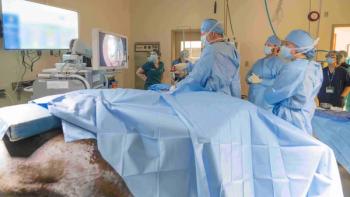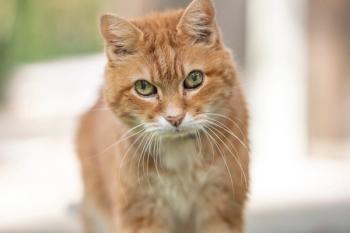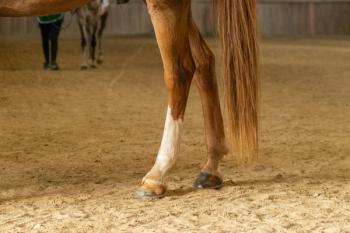
A pain in the joint: Using hyaluronic acid for equine inflammation
A proactive approach with HA may help delay onset of osteoarthritis in racehorses and other equine athletes.
The stress of action, training, racing and joint movement can create wear and tear, tenderness, soreness and painful inflammation in the joints of a horse. (Getty Images.)Due to routine exercise and racing, the knees, hocks, fetlocks and stifle joints of racehorses are highly susceptible to acute stress and painful inflammation. This trauma creates soreness, lameness, synovitis and, depending on management and degree of damage, may potentially lead to osteoarthritis (OA).
The horse's joints-where bone ends meet-are susceptible to wear and tear, damage and disease. In a healthy horse's joint, articular cartilage covers the bone ends in the interior of the joint and the synovium lines the inside of the joint capsule. Both cartilage and synovium are bathed in joint fluid. The bathing of the joints in synovial fluid, which is rich in hyaluronic acid (HA), helps to alleviate friction in healthy joints. But the prolonged stress of action, training, racing and joint movement can create wear and tear, tenderness, soreness and painful inflammation.
As a result, joint disease is fairly common in racehorses. Disturbances within the joint due to athletic training can result in inflammation within the synovial membrane, or synovitis. This inflammation may produce increased amounts of joint fluid that is less effective at lubricating the joint, which can lead to swelling, soreness, pain and lameness in the horse.
The inflammatory cascade compromises the integrity of the joint cartilage, resulting in degeneration of the joint and the development of osteoarthritis. Due to excessive concussion, a variety of enzymes, cytokines, prostaglandins and free radicals-a cascade of inflammation to the joint-is produced. Osteoarthritis is the end result of acute injury to the joint, producing progressive loss of articular cartilage on the bone surface.
Common treatment medications
Jeff Blea, DVM, of von Bluecher, Blea, Hunkin Equine Medicine and Surgery in Sierra Madre, California, also former president of the American Association of Equine Practitioners, says that in racehorses he uses hyaluronic acid both intravenously (IV) and intra-articularly (IA). “When we inject joints to treat disease or symptoms, we often combine the HA with corticosteroids,” he says. “We tend to use intravenous HA on a weekly basis or when we're nearing a high-stress event such as breezing or racing.”
Blea says horses often experience clinical signs such as synovitis, heat in the joint or effusion even when there is no radiographic evidence of pathology. In these cases he treats horses with intravenous hyaluronic acid or intramuscular (IM) polysulfated glycosaminoglycans (PSGAGs). “The intravenous drugs such as hyaluronic acid and the PSGAGs are pretty effective therapies to treat a lot of the clinical symptoms related to early osteoarthritis in the athletic horse,” he says.
Research conducted at Colorado State University on horses with traumatic joint disease has shown that injectable HA can lead to improvement in lameness scores, clinical signs and joint disease, Blea says. “Because these horses are training daily, breezing weekly and most probably racing every three to four weeks, their joints are going to be affected by a lot of pressure and stress,” he says. “It behooves us to be proactive by treating these early signs of joint disease with therapies like IV hyaluronic acid and/or PSGAGs.”
Of course, when you decide to inject a joint, there are a number of different methods using the different products. “I'm more comfortable with injecting intra-articular hyaluronic acid with a corticosteroid,” Blea says. “I get better results. I think the joints do better. I think the horses do better. As athletes, they constantly go through the rigors of training and racing, and the joints are a delicate part of the horse's anatomy, subject to stress and trauma. Being proactive goes a long way rather than being reactive. By being proactive with products like HA or PSGAGs, I think you do a lot of good for the horse.”
Blea says he believes that treatment of subclinical synovitis in racehorse joints with hyaluronic acid is a practical and beneficial option for preventing further development of osteoarthritis. “Osteoarthritis is a cascade of events and it is of value to be proactive in managing it,” he says.
Other treatments for equine lameness, joint issues
Blea says equine rehabilitation has risen “like a Phoenix” in the past five years. “It's very similar to human physical therapy for athletes,” he notes. “For racehorses, ice is commonly used as an anti-inflammatory to treat signs of joint disease or inflammation. It won't make the disease go away, but it helps treat the soreness. Human athletes are often treated in ice baths on a daily basis. The treatment is similar with racehorses.”
Massage turbulators, or whirlpools, are also used but not as commonly, Blea says. Saltwater baths at 33 degrees F use salt-infused water to treat not only joint inflammation, but also sore feet. These are often small tubs with jets, like a human athlete uses a turbulator, Blea says.
A “vibe plate” has also recently become available for horses, Blea says. “It provides vibration as the horse stands on it,” he explains. “These devices lack scientific research at this point, but they're being evaluated and used to be treat mild inflammatory conditions.”
Other therapies such as ultrasound and lasers are also being used to treat inflammation within the limbs of the horse.
“If you equate human physical therapy to equine rehabilitation, we're catching up by leaps and bounds,” Blea says. “We are treating racehorses similar to the way we treat human athletes. By being proactive you have more longevity and more soundness as the end result.”
Even acupuncture is being used to treat horses. One of Blea's partners went through a program at Colorado State University to become certified in equine acupuncture, so his practice offers that modality now as well.
“If you look from the 30,000-foot view, there's a lot of progressive thinking going on in the racehorse industry regarding therapy and rehabilitation,” Blea says. Besides the treatments already discussed, stem cell and biologics are also advancing and proving to be effective in treating joint disease.
“We're getting away from medication and getting back to treating with the ‘old-fashioned,' hands-on manner in some respects-using massage, acupuncture, lasers-to treat inflammation and soreness to keep the athletic horse performing at his best. We don't have to go to medication in every case.
“Still, hyaluronic acid (both IV and IA), corticosteroids and PSGAGs have their place and are very beneficial,” Blea concludes. “They are definitely products you use to treat specific conditions with specific expected outcomes. They're not detrimental if used judiciously, like anything else. They are effective therapeutic medications to treat early joint disease.
Ed Kane, PhD, is a researcher and consultant in animal nutrition. He is an author and editor on nutrition, physiology and veterinary medicine with a background in horses, pets and livestock. Kane is based in Seattle, Washington.
Newsletter
From exam room tips to practice management insights, get trusted veterinary news delivered straight to your inbox—subscribe to dvm360.




